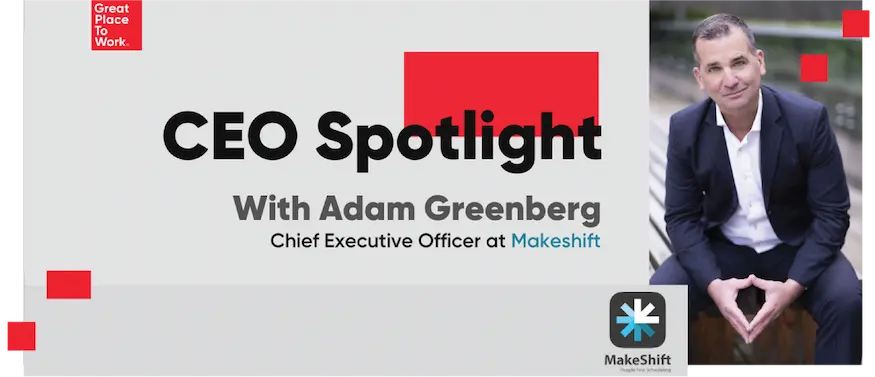
Adam Greenberg is the President & CEO of MakeShift, a shift scheduling app for various industries. He has over 25 years of executive management experience and is also the Founder and CEO of leaders2give.org, a non-profit organization that aims to protect vulnerable children in developing communities and communities in crisis.
At Great Place to Work®, we recognize the crucial role that effective leadership plays in building a thriving organization. We're thrilled to connect with Adam Greenberg, CEO of Makeshift, to learn more about his leadership style and how it contributes to creating a dynamic and innovative workplace culture. With a clear focus on empowering his team and driving positive change.
Nancy: Can you describe your leadership style and how it has contributed to the growth of the company?
Adam: My leadership style is to outline the vision for the business and to empower my team to execute on their goals for our collective success. My approach is to hire really capable people and then to stay out of their way while letting them know that I’m also ready and willing to stand with them to the best of my ability to get the work done. I make sure they know that I don't profess to have all of the answers or the solutions to every problem but that collectively we can figure things out. That failure is a step towards achievement and that we are all in this together. I like to think of this as influence vs authority. Authority is something that is earned. I am not a developer so even though I’m in a position of power as the CEO I am not the authority on their work but if they need help they can come to me to find the resources to best support the outcomes our customers are counting on us to achieve.
Nancy: What do you consider to be the most important factor in the success of a company and how have you applied this in your role as CEO?
Adam: We look at success based on the impact we are making on our peoples lives outside of the office. Can employees buy their first home, take a vacation to a special destination, have the time and safety to plan to start a family, save enough to retire, have the flexibility to attend their children’s hockey proactively and so on. If we can do these things we are running a successful company. The financial KPI’s are table-stakes. We have to achieve them in order to operate and if we can’t we aren’t any good to anyone but I truly believe in business as a force for good in our communities. Being certified as a great place to work for example, to me, demonstrates our success. Interestingly in the same year that our employees rated us with such a high level of trust is the same year our product won multiple awards and we are experiencing strong growth.
Nancy: Can you share a specific example of a challenge the company faced and how you approached finding a solution?
Adam: Hiring is a challenge all companies our size face. We are very deliberate with how and who we hire. We look for the 3F’s - Fit, Flexibility, Fun. The job has to be the right fit for the right person so that they have fun doing the work in a flexible, outcome-driven work environment. Two of the ways in which we have approached finding a solution is by covering the cost of professional development and promoting from within.
Nancy: Can you talk about how you prioritize and allocate resources within the company to drive growth?
Adam: We try to prioritize our resourcing based on two key tenants. Revenue retention and new revenue generation - in that order. For example, we invested in our employees as step one.
Next, we invested heavily in product engineering, so that our customers would have an award winning, world-class product upon which they can run their business.
Then, we invested in customer success processes and resources. Sales and marketing came last. It’s a bit counter intuitive but I strongly believe that if we take good care of employees they will take good care of our customers and our customers will help us acquire new customers and so on.
Nancy: How do you involve and engage employees in the company's growth strategy, and what role do they play in driving success?
Adam: At the beginning of the year I host an all hands call to review our achievements from the year past and outline the goals for the year ahead. I outline the company goals and the mandate for each departmental leader. Then the departmental leaders meet with their teams to not only cascade core goals but to discuss additional initiatives employees believe their teams should pursue. It’s a participative process. Our collective progress is then reviewed during our monthly all hands call. During these calls each department also provides an update. Employees are also rewarded by achieving their individual goals and rewarded when the company achieves its collective goals. All of this is tracked in our performance management system for ongoing transparency.
Nancy: Can you describe the role of continuous improvement (Kaizen) in MakeShift's business strategy and how it has helped drive growth?
Adam: The key to continuous improvement is to celebrate not only our successes but to celebrate what’s been learned from our mistakes. I try to foster a culture of vulnerability so that people feel safe to share in this way. It’s not easy because people naturally don’t want to expose their mistakes and I truly believe in positive intent. People genuinely want to do their best work. From time to time we bring in guest speakers as well. For example we brought in a retired Navy Seal Commander who talked to the team about fear and failure and the importance of relying on your team. I think it was a powerful lesson that regardless of your job and whether you are jumping out of planes to get bad guys or dealing with a difficult customer or problematic code we are doing the best we can.
Nancy: Can you talk about the impact of MakeShift's values (Fun, Unity, Community, Kaizen) on employee morale and company growth?
Adam: Our values act as our guide. Our north star. There’s always work to be done. There’s always deadlines. There’s always stretch goals. How does one prioritize when everything is a priority? Our values are like a checklist of questions to help us decide how best to approach the most difficult tasks and decisions. Since we are all in this together, it’s important to know that we share the same values.
About Great Place to Work®
Great Place to Work® makes it easy to survey your employees, uncover actionable insights and get recognized for your great company culture. Clients apply our insights, advice, and tools to fuel the vision, decisions and actions that drive business performance.
Learn more about Great Place to Work Certification.














